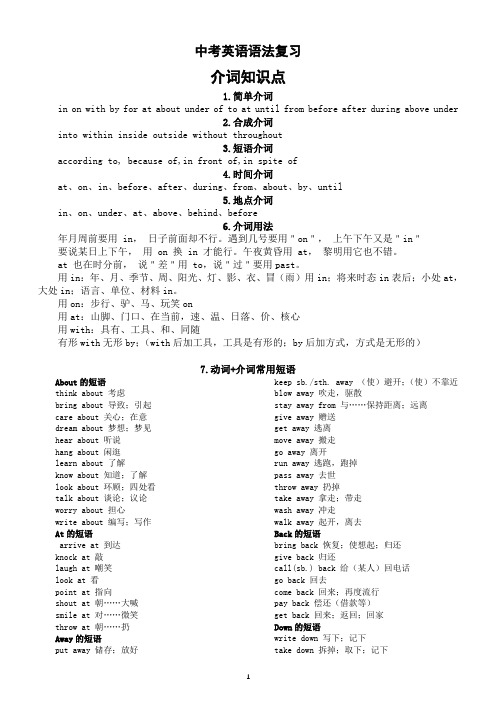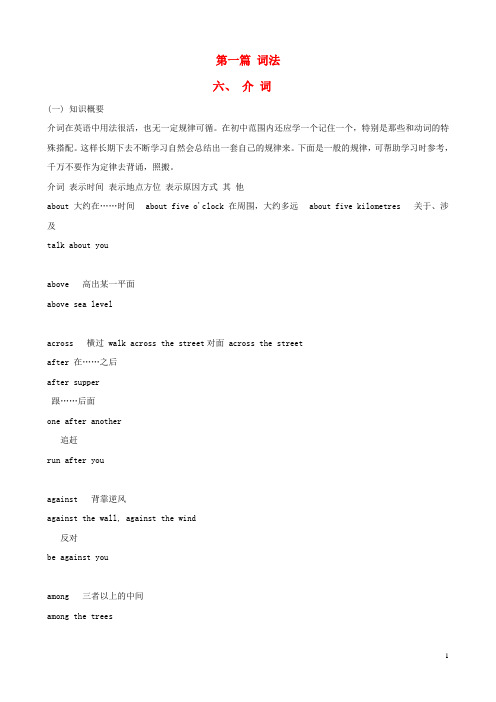2017年外研版中考英语语法介词专题复习正式版
- 格式:pdf
- 大小:5.07 MB
- 文档页数:47

中考英语语法复习介词知识点1.简单介词in on with by for at about under of to at until from before after during above under2.合成介词into within inside outside without throughout3.短语介词according to, because of,in front of,in spite of4.时间介词at、on、in、before、after、during、from、about、by、until5.地点介词in、on、under、at、above、behind、before6.介词用法年月周前要用 in,日子前面却不行。
遇到几号要用"on",上午下午又是"in"要说某日上下午,用 on 换 in 才能行。
午夜黄昏用 at,黎明用它也不错。
at 也在时分前,说"差"用 to,说"过"要用past。
用in:年、月、季节、周、阳光、灯、影、衣、冒(雨)用in;将来时态in表后;小处at,大处in;语言、单位、材料in。
用on:步行、驴、马、玩笑on用at:山脚、门口、在当前,速、温、日落、价、核心用with:具有、工具、和、同随有形with无形by;(with后加工具,工具是有形的;by后加方式,方式是无形的)7.动词+介词常用短语About的短语think about 考虑bring about 导致;引起care about 关心;在意dream about 梦想;梦见hear about 听说hang about 闲逛learn about 了解know about 知道;了解look about 环顾;四处看talk about 谈论;议论worry about 担心write about 编写;写作At的短语arrive at 到达knock at 敲laugh at 嘲笑look at 看point at 指向shout at 朝……大喊smile at 对……微笑throw at 朝……扔Away的短语put away 储存;放好keep sb./sth. away (使)避开;(使)不靠近blow away 吹走,驱散stay away from 与……保持距离;远离give away 赠送get away 逃离move away 搬走go away 离开run away 逃跑,跑掉pass away 去世throw away 扔掉take away 拿走;带走wash away 冲走walk away 起开,离去Back的短语bring back 恢复;使想起;归还give back 归还call(sb.) back 给(某人)回电话go back 回去come back 回来;再度流行pay back 偿还(借款等)get back 回来;返回;回家Down的短语write down 写下;记下take down 拆掉;取下;记下1break down 停止运转;(机器等)出故障turn down 把调低;关小;拒绝calm down 冷静下来cut down 砍倒;缩减die down 减弱;逐渐平息fall down 倒塌;跌倒lie down 躺下pull down 拆除;摧毁put down 放下;记下sit down 坐下slow down (使)减速;(使)放松For的短语search for 搜索;查找thanks for 因……而感激die for 为而死care for 照顾;关怀look for 寻找leave for 动身去pay for 为……付钱stand for 代表prepare for 为……做准备wait for 等待Off的短语burn off 燃烧turn off 关掉cut off 切断;中断break off 突然中止;中断give off 散发;释放get off 下车keep off (使)不接近;远离go off 熄灭;响起put off 推迟;拖延pay off 还清(欠款);成功see off 送行run off 跑掉;逃跑show off 炫耀;显摆set off 动身;启程;使爆炸take off 脱下衣服;(飞机等)起飞shut off 关闭;停止运转On的短语hold on 等一等(别挂电话)pass on 传递keep on 继续(进行)try on 试穿take on 承担;呈现work on 从事;忙于agree on 对意见……一致come on 加油carry on 继续call on 访问;拜访depend on 依靠;依赖;视……而定;取决于decide on 决定;选定get on 上车;进展go on 继续live/feed on 以……为食;靠……谋生put on 穿上;增重;上演turn on 打开Up的短语drive up 开车end up 最终;结束;到头来fill up 装满;填补fix up 修理give up 放弃make up 编造;化妆pick up 接(某人);捡起look up 查阅;查找set up 建立;创立;建造show up 出席;露面take up 开始做;从事;占据stay up 不睡觉;熬夜turn up 调高(音量);出现wake up 睡醒;醒来bring up 养育;提出grow up 成长;长大cheer up 使……振奋;hurry up 赶紧clean up 把(……)打扫干净;put up 张贴;举起;搭建cut up 切碎stand up 站起来dress up 穿上盛装;装扮With的短语deal with 处理;应付play with 和……玩耍agree with 赞同;持相同意见catch up with 赶上(或超过)begin/start with 以……开始come up with 提出;想出(主意、回答等)communicate with 和……交流end up with 以……结束connect with 与……联系talk with 和……交谈part with 放弃;舍弃(尤其不舍得的东西);与……分开get along with 和……相处2。

外研版英语中考归纳复习专题:介词【介词】介词是一种虚词,表示名词、代词等与其他词的关系,不能单独作句子成分。
介词后面一般有名词、代词或动名词等作它的宾语(如果是人称代词,则要用宾格),介词和它的宾语构成介词短语,在句中作状语、表语或定语等。
【时间介词】1.at,in与on2.from,since与for3.before与after4.until,during与by【考点训练1】1.China successfully hosted the Belt and Road Forum _____ May,2017. ()A.onB.inC.byD.at2.We usually have the first class ___ 8:00 in the morning. ()A.inB.onC.atD.from3.More and more young people go skating _____ winter. ()A.atB.inC.onD.to4.I’ve had this mobile phone ___ three years. ()A.byB.fromC.forD.since5.His grandfather has been ill ___ last year. ()A.forB.sinceC.fromD.after6.___ April 22nd,people around the world celebrate Earth Day in different ways. ()A.InB.AtC.OnD.For 【方位介词】1.at与in2.in,on与toto表示在某一地区之外的某方位(不属于该范围)。
Japan is to the east of China.日本在中国的东面。
【图解助记】3.over,above,on,under与below介词含义例句【图解助记】4.其他方位介词near 在……附近next to在……旁边,附近beside在……旁边under 在……下面behind在……后面inside在……里面outside 在……外面along沿着across from在……对面【考点训练2】1.—Where is Mary flying?—She is flying to France soon.She will arrive ___ Paris on the morning of July2. ()A.toB.atC.inD.on2.I can’t see Lucy because she is ___ the tree. ()A.in front ofB.behindC.next toD.beside3.Russia lies ___ the north of China. ()A.onB.toC.inD.at4.The workers will build a new railroad ___ the two cities. ()A.amongB.inC.betweenD.at5.—Oh,my God! I’ve left my keys in the room.I’ll have to get in ___ the window.—It’s dangerous.You’d better wait for your dad to come back. ()A.past B.over C.across D.through【方式介词】考点训练3】用适当的方式介词填空。

第一篇词法六、介词(一) 知识概要介词在英语中用法很活,也无一定规律可循。
在初中范围内还应学一个记住一个,特别是那些和动词的特殊搭配。
这样长期下去不断学习自然会总结出一套自己的规律来。
下面是一般的规律,可帮助学习时参考,千万不要作为定律去背诵,照搬。
介词表示时间表示地点方位表示原因方式其他about 大约在……时间 about five o'clock 在周围,大约多远 about five kilometres 关于、涉及talk about youabove 高出某一平面above sea levelacross 横过 walk across the street对面 across the streetafter 在……之后after supper跟……后面one after another追赶run after youagainst 背靠逆风against the wall, against the wind反对be against youamong 三者以上的中间among the treesat 在某时刻at ten在小地点at the school gate表示速度at high speed向着,对着at mebefore 在……之前before lunch位于……之前sit before mebehind 位于……之后behind the treebelow 低于……水平below zero不合格below the standardby 到……时刻,在……时刻之前by five o'clock紧挨着site by site乘坐交通工具 by air, by bick 被由was made by usduring 在……期间during the holidays for 延续多长时间for five years向……去leave for Shanghai 为了,对于be good for youfrom 从某时到……某时 from morning till night 来自何方 from New York由某原料制成be made from来自何处where are you fromin 在年、月、周较长时间内 in a week 在里面in the room用某种语言 in English 穿着in redinto 进入……里面walk into除分divide into变动turn into waternear 接近某时 near five years 在……附近 near the park of 用某种原料制成be made of属于……性质a map of U. S .Aon 某日、某日的上下午on Sunday afternoon 在……上面on the desk 靠吃……为生live on rice 关于 a book on Physicsover 渡过一整段时间 work over night 在上方over the desk超过,高于 over five pairspast 超过某一时刻ten past five经过某地walk past the parksince 从某时以来since 1980原因Since you were illthrough 经过某一时期 through his life 通过、穿过某地 through the foresttill until 直到某时为止 till five o'clockto 差多少时间five to ten问,到,去往to Shanghai面对面face to face给予give a book to meunder 在……下面under the desk少于under ten在……管制之下 under the rulewith 用某种工具 with a pen 带着,具有with mewithout 没有without air(二) 正误辨析[误] We got to the top of the mountain in daybreak.[正] We got to the top of the mountain at day break.[析] at用于具体时刻之前,如:sunrise, midday, noon, sunset, midnight, night。

中考英语语法详解:介词、连词2017年中考英语语法详解:介词、连词语法是学好英语的基础,为帮助大家积累更多的语法知识,以下是店铺搜索整理的关于2017年中考英语语法详解:介词、连词,供参考学习,希望对大家有所帮助!想了解更多相关信息请持续关注我们店铺!一. 介词1. 介词概述:介词表示它与后面的名词或代词与其他句子成分的关系。
介词是虚词,不能单独做句子成分。
介词在英语中用法很活,也无一定规律可循。
在初中范围内还应学一个记住一个,特别是那些和动词的特殊搭配。
2. 常用介词的意义和用法。
⑴ 时间或地点介词in、on、at的用法区别:表示时间时, in表示在一段时间里(在将来时句子中则表示在一段时间之后), on表示在具体的某一天或者某天的上下午等, at表示在某个时刻或者瞬间;表示地点时, in表示在某个范围之内, on表示在某个平面上或与一个面相接触,at则表示在某个具体的场所或地点。
如:He was born on the night of May 10th.I usually get up at 7:00 in the morning.His glasses are on the desk.My brother is at the bus stop.⑵ after与in表示时间的用法区别:“after+(具体时刻/从句)”表示“在…时刻之后”常用于一般过去时态;“in+(一段时间)”表示“在(多久)之后”,常用于将来时态。
如:He said that he would come back after 6:00.My father is coming back from Astralia in about a month.⑶ since与for表示时间的'用法区别:“since+(具体时刻/that-从句)”表示“自从…起一直到现在”,“for +(一段时间)”表示“持续一段时间”,都常用于完成时态;如:My father has worked in this factory since 1970.My father has worked in this factory for over 30 years.⑷ by、in与with表示方式的用法区别:都可以表示“工具、手段”,但是by主要表示“乘坐”某个交通工具或“以……方式”,在被动句中可以表示动作的执行者;in表示“使用”某种语言/文字,with表示“使用”某个具体的工具、手段。

I介词的功能 介词是⼀种虚词,⽤来表⽰名词或相当于名词的其它词语句中其它词的关系,不能单独使⽤。
介词可与名词或相当于名词的其它词构成介词短语。
介词短语可在句中作定语,状语,表语和宾语补⾜语。
例如: The boy over there is John’s brother. (定语) The girl will be back in two hours. (状语) Our English teacher is from Australia. (表语) Help yourself to some fish. (宾语补⾜语) II表⽰时间的介词 表⽰“时间”的介词如下: 1.表⽰年、⽉、⽇、时刻等⽤at,in,on 2.表⽰时间的前后⽤ before, after 3.表⽰期限等⽤by,until,till 4.表⽰期间等⽤for,during,through 5.表⽰时间的起点等⽤ from, since 6.表⽰时间的经过等⽤in,within (1) at,on,in 1)at:⽤于表⽰时刻、时间的某⼀点 at noon正午时 at night在夜间 at present⽬前 at nine(o’clock)在九点钟 We usually have lunch at noon(at twelve). 我们通常中午吃午饭(⼗⼆点吃午饭)。
(2)on:⽤于某天,某⼀天的上、下午(指具体的某⼀天时,⼀律⽤on) 注意 : 泛指⼀般的上午(下午)时⽤in,但特指某⽇的上午(下午)时⽤on。
in the morning在早上 on sun day morning在周⽇早上 on Monday在周⼀ on Tuesday morning在周⼆早上 on June 6在6⽉6⽇ on May 4,1996在1996年5⽉4⽇ on a cold night在⼀个寒冷的夜晚 on the night of July(the) first 在七⽉⼀⽇的夜晚 We didn't listen to the lecture on Wednesday afternoon 上周三下午我们没去听演讲。

外研版九年级英语语法整理第一章:动词1.1 动词的分类动词可以分为实义动词、助动词和情态动词。
1.2 实义动词实义动词表示主语的动作或状态。
例如:eat, drink, read, write。
1.3 助动词助动词帮助构成时态、语气和疑问句。
常用的助动词有:do, does, did, have, has, had。
1.4 情态动词情态动词表示可能性、能力、建议、命令等。
常用的情态动词有:can, may, must, shall, will。
1.5 动词的时态动词的时态表示动作发生的时间。
常用的时态有:现在时、过去时、将来时。
1.6 动词的语态动词的语态表示主语与动作的关系。
常用的语态有:主动语态、被动语态。
第二章:名词2.1 名词的分类名词可以分为可数名词和不可数名词。
2.2 可数名词可数名词表示可以数的事物。
例如:boy, girl, book, pen。
2.3 不可数名词不可数名词表示不能数的事物。
例如:water, air, rice。
2.4 名词的所有格名词的所有格表示名词所表示的人或事物所属的关系。
例如:my book, the boy's pen。
第三章:形容词和副词3.1 形容词形容词用来修饰名词,表示名词的性质、状态等。
例如:big, tall, happy。
3.2 副词副词用来修饰动词、形容词或其他副词,表示程度、时间、地点等。
例如:quickly, happily, always。
3.3 形容词和副词的比较级和最高级形容词和副词的比较级和最高级表示程度的大小。
第四章:代词4.1 代词的分类代词可以分为人称代词、物主代词、反身代词、指示代词、疑问代词和关系代词。
4.2 人称代词人称代词表示人的称呼。
例如:I, you, he, she, it, we, they。
4.3 物主代词物主代词表示所有关系。
例如:my, your, his, her, its, our, their。
介词一、介词的概念介词常置于名词或代词之后,表示该词与其他成分之间的关系。
一般在句中不单独作任何句子成分。
二、介词的分类根据介词本身的意义,可将介词分为时间介词、方位介词、动向介词、方式介词和原因介词等。
三、常用介词的用法1.表示时间的介词(1)at , in 和onat: ①表示具体的时刻。
如:at six o’clock.②表示一段较短的时间。
如:at night, at noon.③表示人的年龄,常用短语at the age of ..., 如:at the age of ten.in: ①常与上午、下午、晚上连用。
如:in the morning, in the afternoon.②常与月份、季节、年份连用。
如:in May, in summer, in 2014.on: ①常与星期连用。
如:on Monday.②常与日期连用,指具体到某一天。
如:on May 1st, 2014.③常与表示具体的某一天上午、下午、晚上连用。
如:on Friday morning, on a rainy afternoon, on the evening of May 5th.(2)before 和after: 用来表示时间的先后顺序。
before:在……之前after:在……之后如:Spring comes before summer. 夏天之前是春天。
Come to my office after class. 放学后来我的办公室。
(3)from 用来表示从某段时间开始的动作,常与to 连用构成短语“from…to…”译为“从……到……”。
如:They worked in the farm from morning to evening.他们从早到晚都在农场工温馨提示:from…to…还可以表示:从一个地方到另一个地方。
如:A message is from one computer to another.(1) at, in和on①at 用于表示一个较小的场合。
中考英语语法专题详解三:介词、连词介词、连词是英语中使用的特别多的,那么我平常是怎么的用法呢,下面就是我给大家带来的中考英语语法专题详解三:介词、连词,盼望能关心到大家!介词、连词一、介词1. 介词概述:介词表示它与后面的名词或代词与其他(句子)成分的关系。
介词是虚词,不能单独做句子成分。
介词在英语中用法很活,也无肯定规律可循。
在学校范围内还应学一个记住一个,特殊是那些和动词的特别搭配。
2. 常用介词的意义和用法。
⑴ 时间或地点介词in、on、at的用法区分:表示时间时, in表示在一段时间里(在将来时句子中则表示在一段时间之后), on表示在详细的某一天或者某天的上下午等, at 表示在某个时刻或者瞬间;表示地点时, in表示在某个范围之内, on表示在某个平面上或与一个(面相)接触,at则表示在某个详细的场所或地点。
如:He was born on the night of May 10th.I usually get up at 7:00 in the morning.His glasses are on the desk.My brother is at the bus stop.⑵ after与in表示时间的用法区分:“after+(详细时刻/从句)”表示“在时刻之后”常用于一般过去时态;“in+(一段时间)”表示“在(多久)之后”,常用于将来时态。
如:He said that he would come back after 6:00.My father is coming back from Astralia in about a month.⑶ since与for表示时间的用法区分:“since+(详细时刻/that-从句)”表示“自从起始终到现在”,“for +(一段时间)”表示“持续一段时间”,都常用于完成时态;如:My father has worked in this factory since 1970.My father has worked in this factory for over 30 years.⑷ by、in与with表示方式的用法区分:都可以表示“工具、手段”,但是by主要表示“乘坐”某个交通工具或“以方式”,在被动句中可以表示动作的执行者;in表示“使用”某种语言/文字,with表示“使用”某个详细的工具、手段。
介词、连词 ⼀. 介词 1. 介词概述:介词表⽰它与后⾯的名词或代词与其他句⼦成分的关系。
介词是虚词,不能单独做句⼦成分。
介词在英语中⽤法很活,也⽆⼀定规律可循。
在初中范围内还应学⼀个记住⼀个,特别是那些和动词的特殊搭配。
2. 常⽤介词的意义和⽤法。
⑴时间或地点介词in、on、at的⽤法区别: 表⽰时间时, in表⽰在⼀段时间⾥(在将来时句⼦中则表⽰在⼀段时间之后), on表⽰在具体的某⼀天或者某天的上下午等, at 表⽰在某个时刻或者瞬间; 表⽰地点时, in表⽰在某个范围之内, on表⽰在某个平⾯上或与⼀个⾯相接触,at则表⽰在某个具体的场所或地点。
如: He was born on the night of May 10th. I usually get up at 7:00 in the morning. His glasses are on the desk. My brother is at the bus stop. ⑵ after与in表⽰时间的⽤法区别:“after+(具体时刻/从句)”表⽰“在…时刻之后”常⽤于⼀般过去时态;“in+(⼀段时间)”表⽰“在(多久)之后”,常⽤于将来时态。
如: He said that he would come back after 6:00. My father is coming back from Astralia in about a month. ⑶ since与for表⽰时间的⽤法区别:“since+(具体时刻/that-从句)”表⽰“⾃从…起⼀直到现在”,“for +(⼀段时间)”表⽰“持续⼀段时间”,都常⽤于完成时态;如: My father has worked in this factory since 1970. My father has worked in this factory for over 30 years. ⑷ by、in与with表⽰⽅式的⽤法区别:都可以表⽰“⼯具、⼿段”,但是by主要表⽰“乘坐”某个交通⼯具或“以……⽅式”,在被动句中可以表⽰动作的执⾏者;in表⽰“使⽤”某种语⾔/⽂字,with表⽰“使⽤”某个具体的⼯具、⼿段。
外研社初三英语语法总复习名词一、名词的分类:根据用法,名词可以分为可数名词和不可数名词两类。
1.可数名词有单、复数形式的区别。
需要掌握规则名词的复数形式的构成。
*以y结尾的专有名词,或元音字母+y 结尾的名词变复数时,直接加s变复数:如:two Marysthe Henrys monkey---monkeysholiday---holidays比较:层楼:storey ---storeys story---stories*以o 结尾的名词,变复数时:a. 加s,如:photo---photospiano---pianos radio---radioszoo---zoos;b. 加es,如:potato--potatoestomato--tomatoes hero--heroes Negro--Negroes*以f或fe 结尾的名词变复数时常去f , fe 加ves ,如:half---halvesknife---knivesleaf---leaveswife---wiveslife---lives thief---thieves2.名词复数的不规则变化1)child---children foot---feettooth---teeth mouse---miceman---men woman---women 注意:与man 和woman构成的合成词,其复数形式也是-men 和-women。
如:an Englishman,two Englishmen. 但German不是合成词,它是由Germany去y变化而来,故复数形式为Germans;Bowman 是姓,其复数是the Bowmans。
2)单复数同形如:deer,sheep,fish,Chinese,Japanese ,jin,yuan,two li,three mu,four jin 但除人民币元、角、分外,美元、英镑、法郎等都有复数形式。